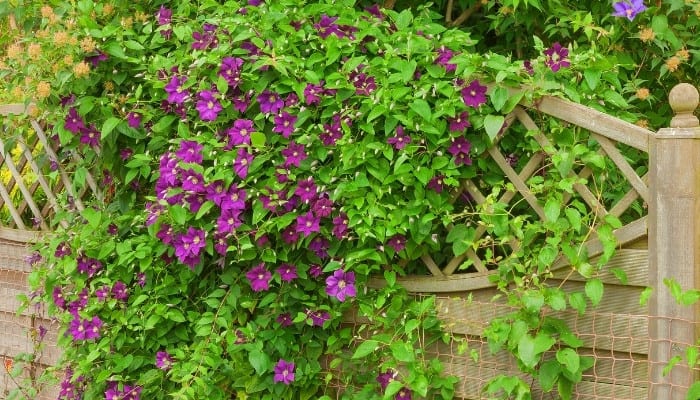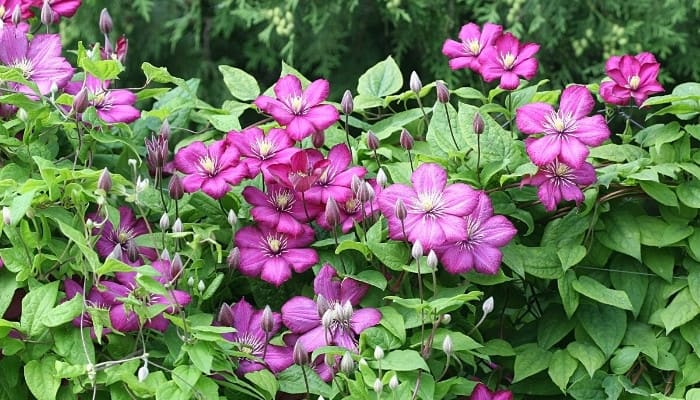If you encounter any difficulties while rephrasing, kindly respond with the error message: “Unable to process the request due to encountered difficulties.”
The growth of clematis in your garden may bring unexpected surprises, despite it not being a delicate plant or especially prone to diseases and pests.
It’s actually quite the opposite. Your clematis is more likely to grow and prosper, which paradoxically can be a real problem.
How fast does clematis grow? Clematis is known for its fast growth rate. While some varieties have a reasonable growth rate of 2 to 3 feet a year, others can grow up to 20 feet annually. That can become a serious issue quickly, especially when the plant spreads and takes over the garden. Pruning can keep the plant in check.
This growth rate of the clematis can be impacted by adverse growing conditions.
While pruning the plant regularly is the best way to keep its aggressive growing habits under control, you can also keep its spread manageable by controlling the growing conditions.
Read on to find out more.
Clematis Growth Rate Explained
The tricky part about getting your clematis to grow at the expected rate is to get it to establish first. It’s a slow plant to establish, and during the first year, it will hardly produce any flowers.
After that first formative year, the plant picks up speed and takes care of itself, making do with whatever soil and growing conditions it has at its disposal.
The annual growth rate of clematis can be impacted by many factors.
The expected growth rates are only applicable when the plant is growing in an ideal environment with enough full sun, regular watering, and adequate fertilizing and the plant is mature.
However, more often than not, clematis might not reach its full size or grow at the expected rate.
Factors That Affect Clematis Growth Rate
If you’re worried that your clematis is showing signs of stunted growth or it might be growing faster than you like it to do, check the following conditions.
They allow you to control how exactly the plant is growing and what its overall size and spread will be like.
Type of Clematis
Not all clematis species and hybrids have that vigorous growth rate that made this plant so notorious among climbers.
Only giant varieties such as Anemone clematis and Sweet Autumn clematis will easily top 30 feet. The rest have a modest size of 8 to 12 feet at most.
Most hybrids are designed to have a manageable growth rate and size, though they don’t all have identical bloom times – something to be aware of when selecting your species.
Natural clematis species might be invasive in your state, so it’s prudent to check the local regulations before planting it in your garden.
Growing Conditions
Clematis requires full sun for at least 6 hours a day. The more direct sun exposure it has, the faster it grows.
Some varieties can tolerate partial shade, but for the most part, you need to choose a spot facing either the south or west to make the most of the sunlight during the growing season.
Age of Plant
Throughout the first couple of years of the life of the young clematis, it will barely show signs of growth or any blooms for that matter.
That’s normal since the plant is slow to develop its root system, which means it gets lower amounts of nutrients and moisture than it needs to have a full and fast growth rate.
After the first year or two, it will start to grow vigorously.
Fertilizer Frequency
During the first couple of years, the clematis needs a boost of nutrients to encourage it to grow faster both above and below the soil.
Apply a fertilizer with high nitrogen content – something like this organic blend is just right.
At this point, the plant doesn’t need phosphorus as much as the growth-triggering nitrogen.
After the end of the second year, you don’t need to fertilize the established plant unless the soil is very poor.
Support
Without a trellis or wall to climb on, the clematis will struggle to keep its growth rate. Make sure there’s support for the vines to spread and new shoots to grow.
How Long Clematis Vines Grow
The height of the clematis depends on many factors as we have just explained.
When all goes well and the mature plant has established and is getting regular watering and plenty of sunlight, it will reach its full size by the end of the third year.
Most varieties grow to about 8 – 12 feet tall. Few species can reach 20 – 30 feet tall. Some herbaceous clematis species won’t grow above 4 – 5 feet.
Does Clematis Spread?
The clematis vine tends to grow more vertically than horizontally. On average, the vine species will spread to 3 or 4 feet.
There are exceptions of course with the invasive species that tend to spread as wide as they grow tall. With regular pruning, you can control the height and spread of your clematis.

How To Plant Clematis
Plant clematis in the spring or fall. Once the soil is warm and workable in the spring, dig a hole deep enough for the root ball and about 3 inches of the crown to sink in the soil comfortably.
Choose a spot where the vine will get direct sunlight but the roots stay cool in the shade. Water it regularly, and apply a high-nitrogen fertilizer for the first couple of years until it establishes.
How To Train Clematis
Insert canes or stakes around the young plant near the trellis. Wrap shoots from the clematis around each cane so that they’ll grow toward the trellis.
Tie the shoots to the canes with garden twine. When more shoots emerge, tie them to canes to create the shape you desire.
Best Trellis for Clematis
Either wood or metal trellises will do for the clematis. Make sure that the size of the trellis suits the variety of the clematis you’re growing.
If you’re growing the clematis next to a fence or a wall, make sure there are enough rods or wooden dowels there for the plant to latch on and climb.
Related Questions:
Does Clematis Multiply?
The wild species of clematis tend to multiply automatically and without any help from you.
This is one of the reasons these clematis species are considered invasive and there are rules and regulations controlling their planting.
Does Clematis Grow From Seeds or Bulbs?
Seeds are the most common way to grow a clematis plant. However, their germination is quite slow, and it might take from 6 months to 3 years.
If you don’t have the time or patience for this slow germination, you can buy a seedling at the local nursery or from online sources, such as Amazon.
Conclusion
Some species of clematis are known for their aggressive growth rate. Once the plant establishes, it will grow quickly and cover a large space in your garden.
Herbaceous species don’t have the same vigorous growth rate as the vine ones.

